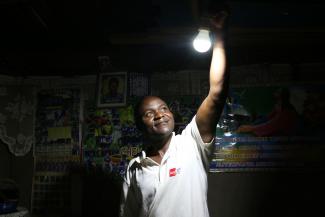OVERVIEW
Until the COVID-19 pandemic, Kenya was one of the fastest growing economies in Africa, with an annual average growth of 5.9% between 2010 and 2018. With a GDP of $95 billion, Kenya recently reached lower-middle income status, and has successfully established a diverse and dynamic economy. It also serves as the point of entry to the larger East African market. However, Kenya continues to face significant challenges to sustainable and inclusive economic growth, which have been exacerbated by COVID-19’s economic disruptions, alongside long-running challenges including corruption and economic inequality.
Two-thirds of Kenyans live in poverty, making less than $3.20 per day and have since Kenya’s independence. As a result, the majority of Kenyans, particularly women and girls, can be considered chronically vulnerable. There is a large gap between the rich and poor, with approximately 70 percent of Kenyan families chronically vulnerable due to poor nutrition, food insecurity, and preventable diseases. Many Kenyans suffer from economic inequality while a minority elite continues to exploit their labor, resources, and opportunities.
USAID partners with the Government of Kenya, the private sector, and the Kenyan people to advance economic prosperity for all. Our vision is that every Kenyan can benefit from Kenya’s development, can grow their business, feed their family, and contribute to Kenya’s future. To do this, we work through Kenyan and U.S. private organizations to implement development projects jointly designed with Kenyans. These organizations partner directly with Kenyan private sector, communities, and county and national governments to promote a level playing field so businesses and people can thrive.
Over the past few years, our collective efforts have improved the economic outlook for Kenya. Together, we have:
Enabled nearly 30,000 small and medium Kenyan agri-businesses access credit
Reduced the time and cost of doing business in Kenya, including a reduction in cross-border transport wait times from 6 days to 6 hours
Supported over one million Kenyans access electricity
Supported the Kenyan private sector to export over $600 million through the African Growth and Opportunity Act (AGOA), making the U.S. the second largest export market for Kenya
Leveraged over $180 million in private sector investments for improved water and food security
PROGRAM AREAS
Agriculture Market Systems
The agricultural sector is the backbone of the economy, contributing approximately 33 percent of Kenya’s Gross Domestic Product (GDP). The agriculture sector employs more than 40 percent of the total population and 70 percent of the rural population. However, agricultural productivity has stagnated in recent years; value addition is limited and many smallholder farmers remain mired in poverty with limited access to competitive markets, finance and improved technology. We work to enhance agriculture-led economic growth, improve nutrition outcomes, strengthen county government capacity, and build sustainable market systems through private sector engagement with self-reliant rural households.
Trade
USAID works with the Government of Kenya and the private sector to increase trade among East African countries and globally. We promote two-way trade and investment linkages between Kenya and the U.S., and help Kenyan and American firms take greater advantage of trade opportunities provided by the African Growth and Opportunity Act (AGOA) and other initiatives. USAID supports a range of trade-related areas including: capacity building, building a private sector enabling environment, better market access, increased food security, and export promotion.
Access to Finance and Investment
Many Kenyan firms, particularly small and medium enterprises, do not have access to finance to grow their businesses. USAID is working closely with the Government of Kenya and the Kenyan and U.S. private sector to encourage greater investment in Kenyan firms and to encourage the banking sector to expand services to underserved Kenyans, with a particular focus on the agricultural sector. We identify opportunities and assist banks and other financial institutions to design financial products to target underserved borrowers. In addition, we provide support for foreign direct investments that support inclusive growth, job creation and productivity enhancements for the Kenyan economy.
Energy Sector
The Government of Kenya has a vision to increase the supply of and access to reliable, affordable, and sustainable electricity, with a target of universal access by 2022. Kenya has one of the most developed power sectors in sub-Saharan Africa, with an active private sector, a strong national power utility, and abundant renewable energy resources, especially geothermal, wind, and solar. Sustainable electricity is needed for strong economic growth. Through the Power Africa initiative, USAID is increasing access to clean, reliable, and affordable electricity supply to drive Kenya’s economic development, while providing opportunities for increased private sector participation. The Power Africa initiative has helped nearly one million Kenyans access electricity through new mini grid installations and solar home systems.
Fact Sheets
Kenya Investment Mechanism Program (KIM)
Small Business Development Centers (SBDC)
Women's Economic Empowerment Initiative (WEE)
Related Documents

Irene Angwenyi/USAID
